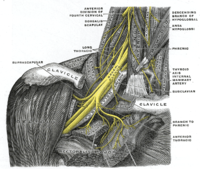
Photo from wikipedia
Purpose: Effects of upper trunk obstetrical brachial plexus palsy (OBPP) on the spinal curvature and relationship between the curvature degrees and upper limb movements have not been reported. Methods: Spinal… Click to show full abstract
Purpose: Effects of upper trunk obstetrical brachial plexus palsy (OBPP) on the spinal curvature and relationship between the curvature degrees and upper limb movements have not been reported. Methods: Spinal Mouse was used to assess spinal curvature characteristics in the sagittal and frontal planes. Upper limb movements were assessed with using the Active Movement Scale in only study group. Results: The degree of frontal plane curvatures was higher in the study group. In the OBPP group, 11 of 25 (44%) children had thoracal C-shaped scoliosis. Nine of these children had contralateral side scoliosis. Shoulder external rotation was inversely correlated with scoliosis angle. Moreover, shoulder external rotation and elbow flexion were lower in children with scoliosis in the OBPP group. Conclusions: Upper trunk OBPP may affect frontal plane alignment. Especially insufficient shoulder external rotation scores may lead to constitute thoracal scoliosis as a result of trunk compensation.
Journal Title: Pediatric Physical Therapy
Year Published: 2019
Link to full text (if available)
Share on Social Media: Sign Up to like & get
recommendations!